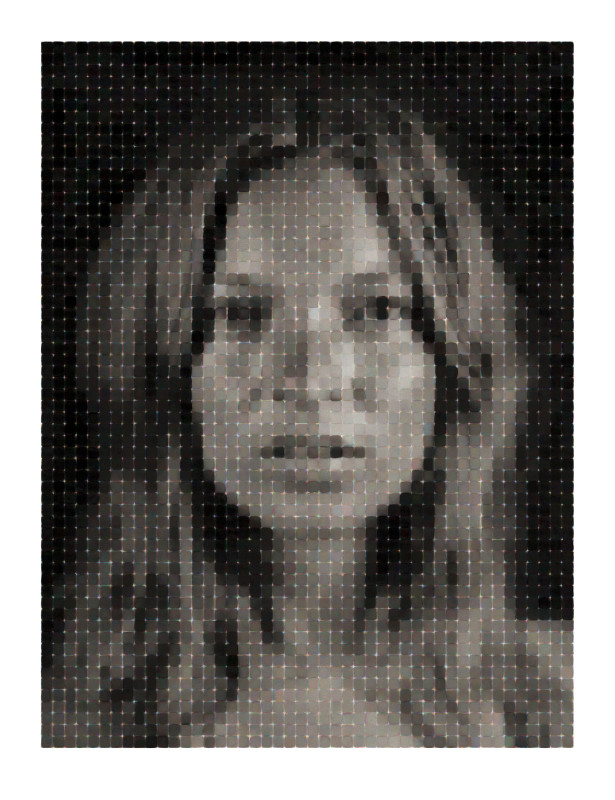
Archival watercolor pigment print on Hahnemühle rag paper
78 x 60 inches
edition of 10
Chuck Close’s watercolor prints are an ongoing series of editioned works on paper, beginning with Self-Portrait (2012), printed and published by Magnolia Editions in Oakland, California. With direct antecedents in Close’s color separation paintings of the 1970s, these works find the artist demonstrating a mastery of color born of decades of cross-medium innovation, as Close combines the virtuosic technique of his celebrated airbrush and oil portraits with the ancient art of ink wash painting, the lyrical vernacular of watercolor, the legacy of darkroom photography, and 21st-century innovations in digital imaging and pigment print technology.
Each watercolor print begins with an original photograph by Close, typically a large format, color Polaroid scanned by Adamson Editions in New York; the artist’s subjects are friends, loved ones, and respected contemporaries. The appellation ‘watercolor print’ refers to a new technique developed by Close and Donald Farnsworth at Magnolia Editions in which the boundaries between painting and printmaking have been intentionally undone, yielding printed multiples with the scale, the complexity, and the palpable ‘wetness’ typically associated with painting. For Close, who has made a career of rigorously exploring the technical boundaries of painting and printmaking individually, the introduction of this technique allows him to explore the signature elements of his portraits – colors built up in painstakingly incremental layers of expressive brushwork, anchored by the cool, scientific axis of the grid – in an entirely new way.
To make the transition from photographic image to watercolor print, Close draws from a library of more than ten thousand unique, hand-painted, monochromatic marks; some were painted by the artist in his New York studio specifically to be used as raw material for the prints, while others were digitally captured by photographer Ben Blackwell at high resolution from a privately owned Close ink wash painting. Over the course of many months, Close recombines these painted marks by first separately assembling the various light and dark values of the image in each of four color channels, then combining the channels to create the final composition, which is printed on a large-scale printer. The twelve colors of ink used in layering the prints generate an overall color gamut far greater than that of the typical four color CMYK printer.
In each edition, the unique size and spacing of the grid and the interaction of the individual marks have been carefully chosen and manipulated with an eye toward retaining the behavior inherent to watercolor. Where colors overlap, their hues and values are combined both digitally and physically to manifest the principles of capillary action, reticulation, and color blending that are native to watercolor painting. To maximize clarity and detail, each print receives multiple passes, wet upon wet: this layering is augmented by months of work by Close and Farnsworth, arranging the various color channels in each image so that when printed, they will ‘behave’ exactly as if every mark were painted directly onto the paper by hand. Each edition is printed onto rag paper using water-based, pigmented ink, generating an additional degree of natural watercolor wicking at the surface of every print.
In the early 1970s, Close created paintings based on photographs but painted by hand, using separate layers of cyan, magenta, and yellow in direct reference to the CMYK color separation system often used in mechanical reproduction. Close himself has suggested that his watercolor prints are the result of a renewed inquiry into the technical and philosophical issues raised by the color separation paintings some forty years earlier. As such, these prints introduce a timely and intriguing new set of visual and technical concerns to the ongoing dialogue within Close’s work between optics, technology, and mimetic representation.
-Nick Stone
show prices
Prices and availability are subject to change without notice.The copyright of all art images belongs to the individual artists and Magnolia Editions, Inc.
©2003-2025 Magnolia Editions, Inc. All rights reserved. contact us
